Blackface Minstrelsy at UVA (PAVS 4500 student paper, spring 2018)
By Sydney Bradley (American Studies, CLAS 2019)
Across the Southern states and into the North, minstrelsy shows were a popular culture phenomenon for most of the 19th century. Blackface minstrelsy is the performance by white men in which the actors paint their face black, dress in drag or in exaggerated costumes, and performed blackness: as primitive, hypersexual, and mischievous. In the latter decades of the 19th century, blackface minstrelsy was thriving and found its own manifestation at the University of Virginia and throughout the City of Charlottesville. Over several decades, the popularity dwindled but revived itself in the early 20th century, and occurred alongside the massive efforts across the nation to consolidate power to white men through racial oppression and violence. Blackface minstrelsy, at its core, is a means by which white men degrade black humanity and rationalize racial oppression.[1] The popularity of blackface minstrelsy at the University of Virginia mirrored the rise in white supremacy and racial violence: when blackface was revived in the 1910s, Charlottesville saw the strengthening of Jim Crow, establishment of the Ku Klux Klan, and the erection of Civil War monuments. Blackface at the University is another chapter in the history of white supremacy on and off Grounds.
Beginning in the 1830s, blackface minstrelsy shows emerged as a popular theatre performance and originated in New York.[2] These performances included blackface makeup and characters which depicted enslaved Africans and took place on Southern plantations. The characterization of these enslaved figures were rooted in the themes laziness, hyper sexuality, mischief, or superstition. In the early years of minstrel shows, the character, “Jim Crow” was coined by Thomas Dartmouth Rice and within years, a new market of blackface through costumes, makeup, music, and plays was established.[3] In 1843, the first minstrel ensemble, the Virginia Minstrels, was formed.[4] A common minstrel show adhered to a pattern of performances and organization, beginning with some jokes and banter, a musical performance with ballads and song, a variety show, and concluding with a one act play and full ensemble song. The main jokers were called “endmen” and began the show and led the comedic antics of the performance.[5] Blackface minstrelsy saw it greatest success during the antebellum period of the South, thriving between 1845 and the end the of the Civil War.[6] After the Civil War concluded, the popularity of the minstrel show dwindled across the country but remained as a common theatrical performance up into the late 19th century.
In 1876, the University Minstrel Troupe was formed at the University of Virginia.[7] The group, founded by student and future actor George D. Fawcett, was made up of student performers.[8] The group was written about at length with high praise, described as a “band of light-hearted University minstrels” and its leader, Fawcett, “was decidedly our best comedian, and according to our judgment made an inimitable end-man.”[9] The minstrel ensemble’s first recorded performance was May 3rd of the same year at Town Hall and in benefit of the Rives Boat Club.[10] The Virginia University Magazine describes this event as “one of so much enjoyment and so creditably gotten up that it will be remembered for months to come as the most delightful affair of the session.”[11] The show began with songs and included a quintet described as “amusing,” a performance titled “Scenes of Minstrelsy” that included Fawcett and received frequent applause from the audience, a band performance “colored and dressed in full uniform” and other segments such as the comic song “Maloney’s Donkey.”[12] Following this musical segment of the performance, came “School-day Sports” in which “several students represented colored boys at school.”[13] The performance closed with a one act play, reflecting the common structure of minstrel shows of the mid-1800s. Both students and citizens “flocked” to Town Hall to witness this performance.
The 1876 was show was a success, and the next year, the University Minstrel Troupe performed another show as a fundraiser for the Rives Boat Club. In 1877, the event was announced and described as “a repetition, with slight variations, of the long-to-be-remembered minstrel performance of last winter.”[14] The tradition continued into 1878, with an announcement in the Virginia University Magazine which described their excitement and “hope that our fellow students will be more patriotic this year, and attend in larger numbers.”[15] Minstrel shows performed by students had grown among the University community as a treat, an entertaining night to look forward to and remember. Across Charlottesville, minstrelsy was beloved, as “The citizens as well as the students possess a remarkable faculty for enjoyment when a ‘nigger minstrel’ or ‘grand gift concert’ is performed…”[16]
For some years, the University Minstrel Troupe is recorded in less frequency but reemerges in 1886 with their performance of The Mikado, a Gilbert and Sullivan production.[17] During this time period, the Minstrel Troupe’s shows would fundraise for the University Chapel and Base-Ball Association.[18] The first part of the concert was a performance of several songs with titles such as “I Am Waiting for My Love’s Return” and “Down by the Deep Sad Sea”.[19] The second part included acts by the “Ebony Quartette” and a “Stump Speech” which are both common performances in minstrelsy shows. The stump speech is a comedic monologue performed in blackface and Black vernacular. This second part also included the “University Quartette Club” and a performance titled “Cheese Notes,” but it is not specified whether or not these would have been in blackface or possessed minstrel qualities. Part three of the play is titled “Berlesque of Mikado” and includes characters such as the governor of Virginia, “Poo-Bah”, “Yum-Yum” as one of three “little maids” and Katisha, described as “old maid from Richmond”.[20] The characters from the original script of The Mikado were altered to fit the context of Virginia from its original setting in Japan. Instead of the usual performance of this play in yellowface, in which white performers presented themselves as Asian, characters donned blackface, “in which the saffron color of the Japs was exchanged for the “nighted” and ebon color of the Ethiopian.”[21] The addition of blackface into this performance, which ordinarily did not include black characters, is a testament to the contexts of racism and white supremacy that permeated in Charlottesville and radiated across the South. Again, the Virginia University Magazine expressed their praise for the Minstrel Troupe. The University Minstrel Troupe dissipated over the years and was never recorded in the university yearbook, Corks and Curls, which began in 1888, seemingly, having disbanded after just over a decade of performances.
During the latter 1880s and into the 1890s, blackface minstrelsy’s popularity dwindled in Charlottesville as it did across the nation. During the 1880s, Blind Tom, a black entertainer, was a featured performance at Town Hall and was a star, subjected to a racist gaze which was both objectifying and otherizing.[22] While neither minstrelsy or blackface, this was a performance consumed by white audiences that allowed them to view the black body as a spectacle, and uphold their racial power. In 1894, although it is not stated why, students protested a visiting tour group’s performance of Uncle Tom’s Cabin and references to minstrelsy performances in the Virginia University Magazine slowly grew less frequent.[23] The surge in popularity of blackface among the University community, Charlottesville, and the South came after the era of post-war and Reconstruction, a time when white identity was in question and the demand to answer this white fragility was through the comedic performance of blackness as a means of degradation of class, power, and humanity.
An emergence of heightened racial intimidation and violence paved a budding new contexts throughout the country which prompted an effortless return to the performance of blackface and minstrelsy tropes. In the 20th century, these instances both filmed and photographed, which perpetuated its popularity and solidification into the cannon of popular culture iconography and performance. Most notably, the film The Birth of a Nation (1915), marks the return of blackface into the realm of pop culture, making its way to White House Theatre and earing the praise of President Woodrow Wilson, “It’s like writing history with lightning. My only regret is that it is all so terribly true.”[24] The film depicts the Ku Klux Klan as a heroic ensemble of white men, rescuing white families and women from the thieving African Americans – all of whom were white actors in blackface. The re-popularization of blackface occurred in tandem with the surge in lynching, revival of the KKK, establishment of Jim Crow, and the construction of Civil War memorials idolizing Southern leaders. The early decades of the 20th century were devoted to a reconstruction of white supremacy and embodied visually through the use of blackface and the return of minstrel stereotypes as entertainment.
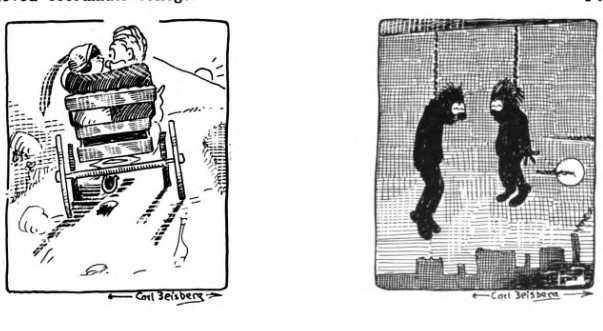
The 1914 Corks and Curls yearbook is year filled with racist cartoons, poems, and comics that either depict blackface or explicitly degrade black characters. In a short story about a young woman named Pearlie and two men, Frank Rogers and Jack McNaughton, the authors conclude with scene of a lynching. The two men, Jack adopting “the disguise of a negro washerwoman and Frank hiding, are found and “strung up on the passenger bridge. The entire edition of Corks and Curls was piled beneath them and set on fire” by university students, led by the Honor Committee.[25] The section concludes with a cartoon image of the two men hanging, as shadowed bodies in the night, indistinguishably white and invoking imagery of lynched black bodies. The story is written in a comedic tone, expressing a trivialization of lynching and embodying the sentiment of UVA students at the time.
Throughout the book, there are several cartoons depicting stereotypical minstrel characters. In a cartoon, a ‘mammy’ character is depicted and shown carrying cleaning supplies and speaking in vernacular.[26] Included as well is a story told from the perspective of Uncle Henry, the former bell-ringer, in vernacular laced with minstrel tropes.[27] A cartoon of formerly enslaved Uncle Peter Briggs accompanies a poem, “The Dance Rehabilitated,” which describes him as “an aged and gray Ethiopian” referred to later in the same stanza as a “nigger” and concludes with “For in him was heroic what in us was mere laughter.”[28] The poem continues to describe his dancing and his being, in a derogatory and imitating manner, and is later summoned as a spirit. His character is for white consumption, to make them laugh. Carl Zeisberg, a common artist used by the Corks and Curls, illustrated both the cartoons of the ‘mammy’ character and of Uncle Peter.
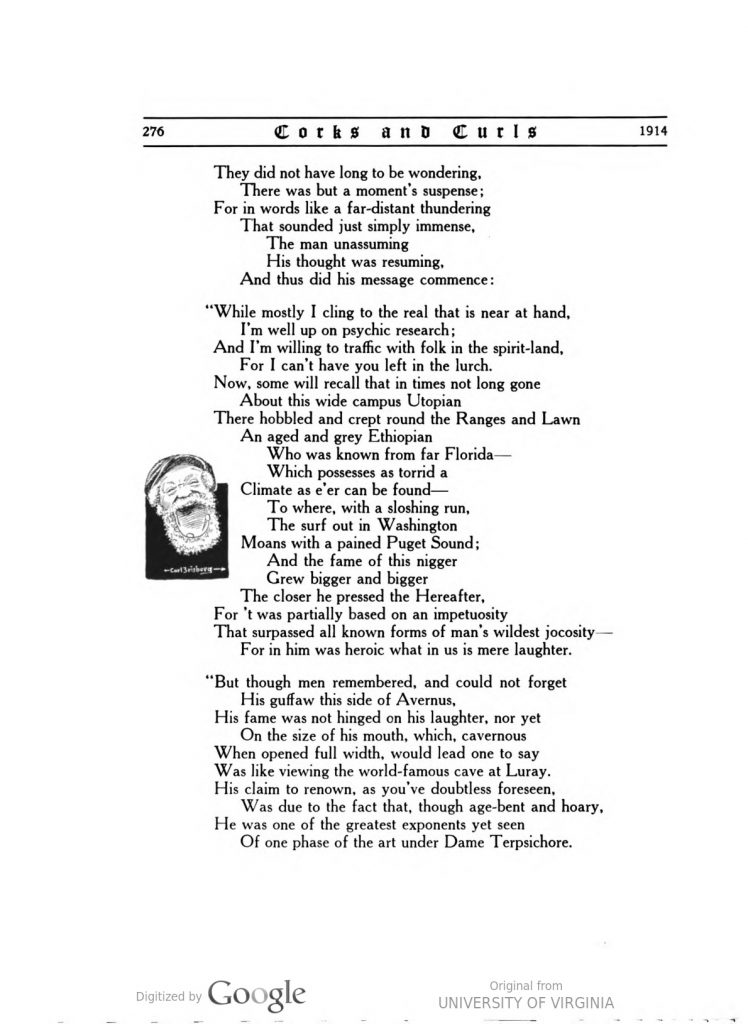
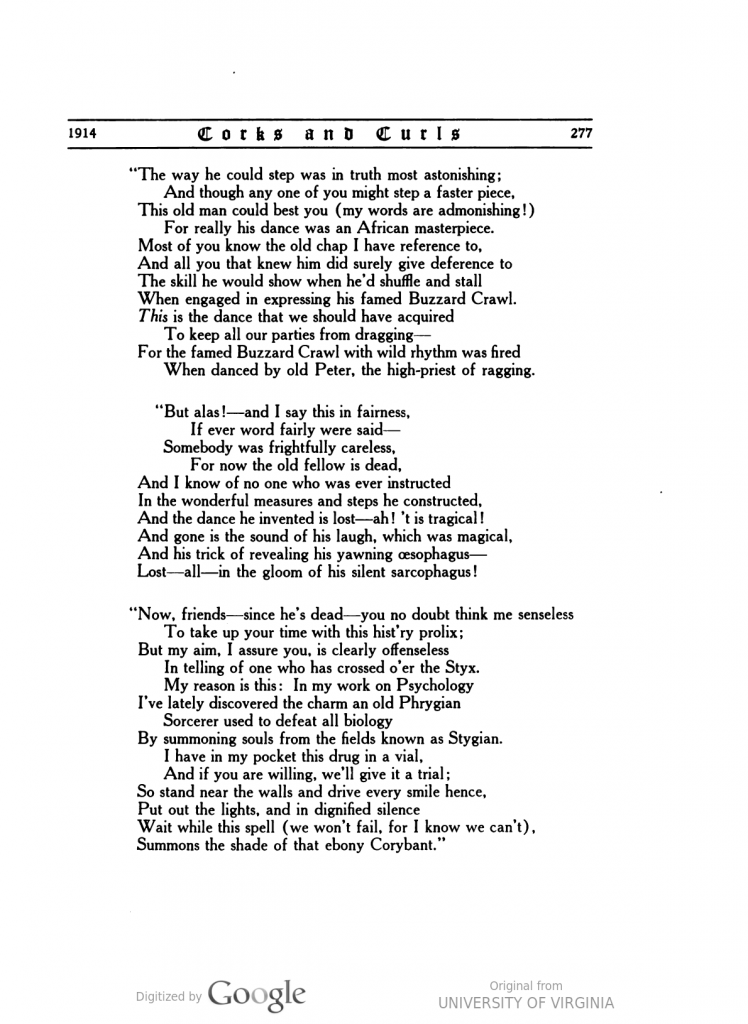
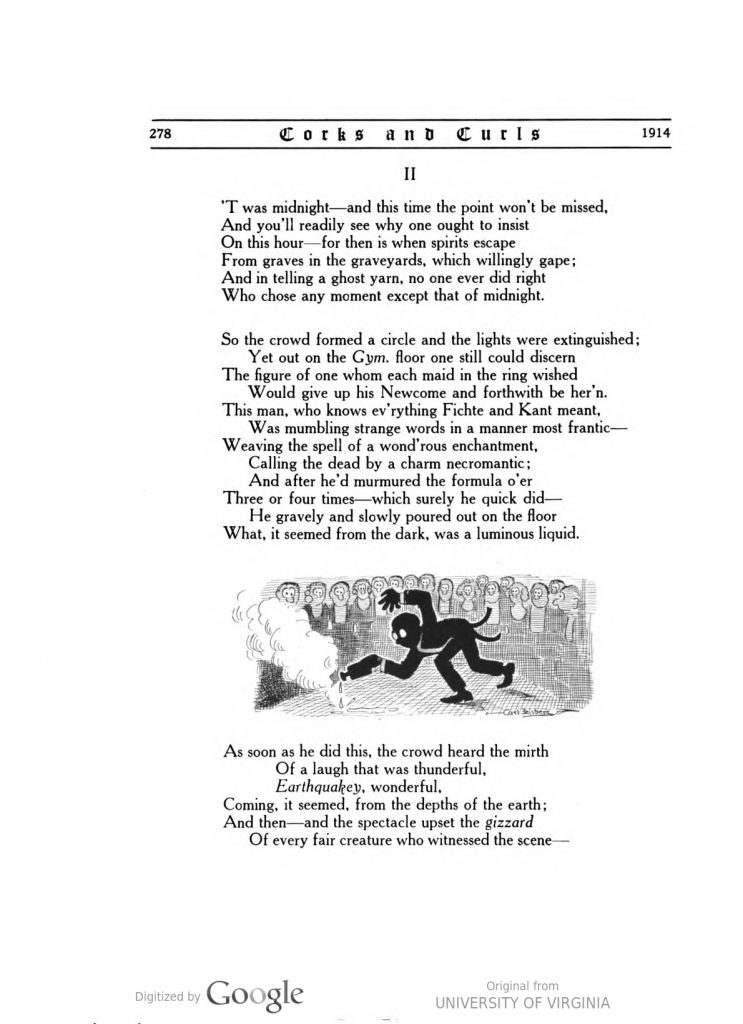
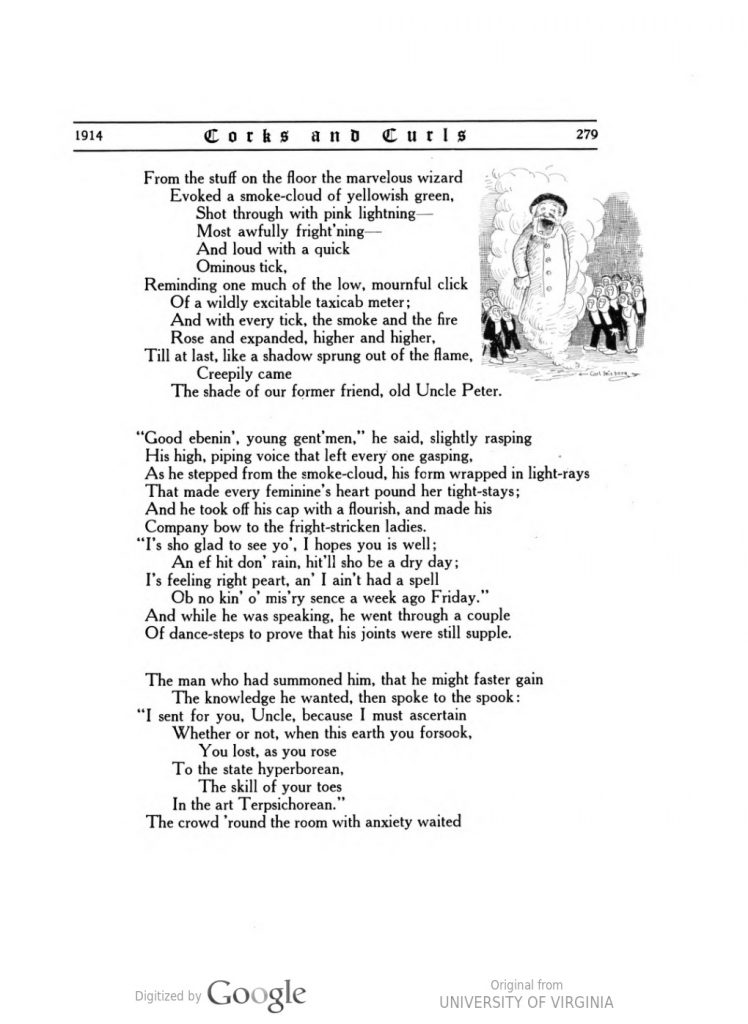
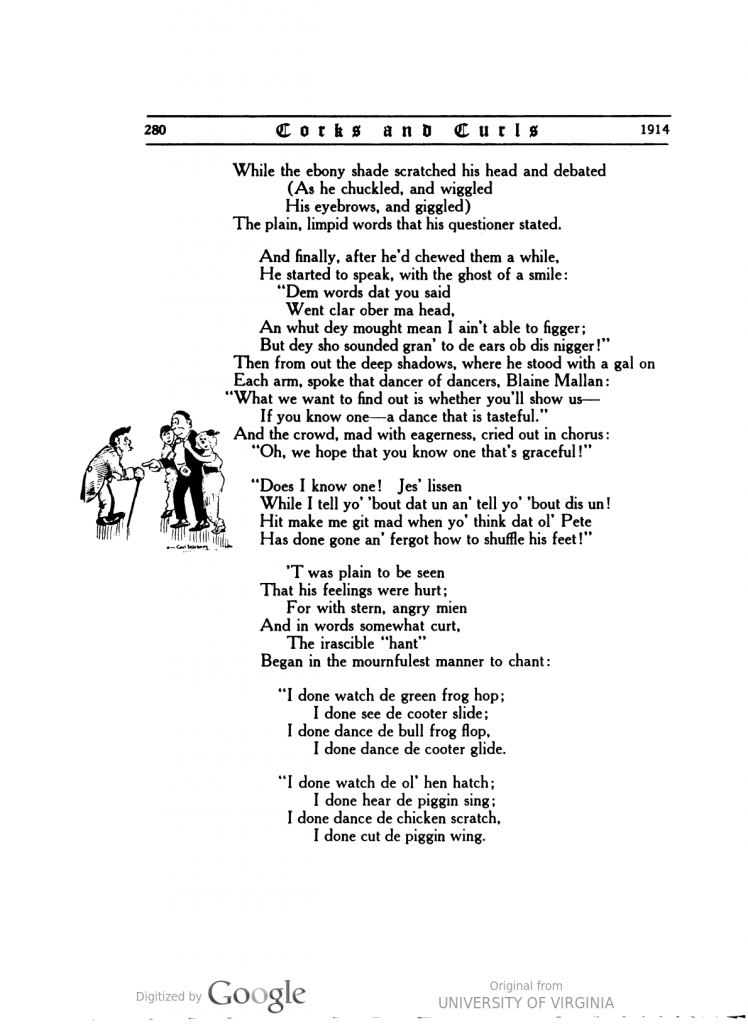
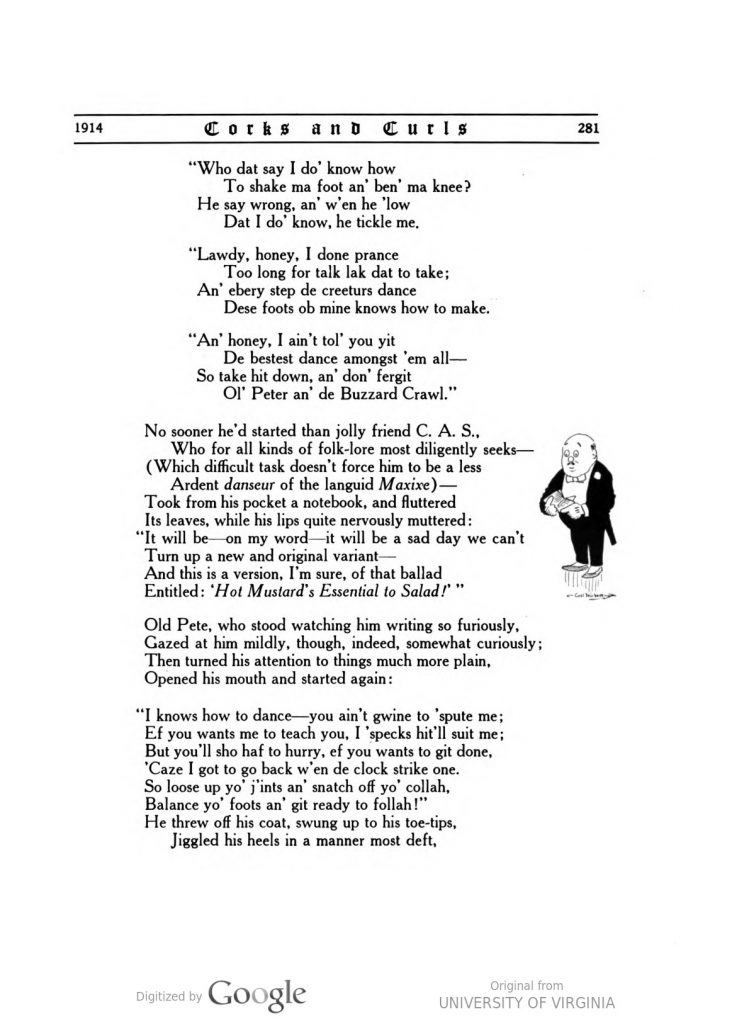
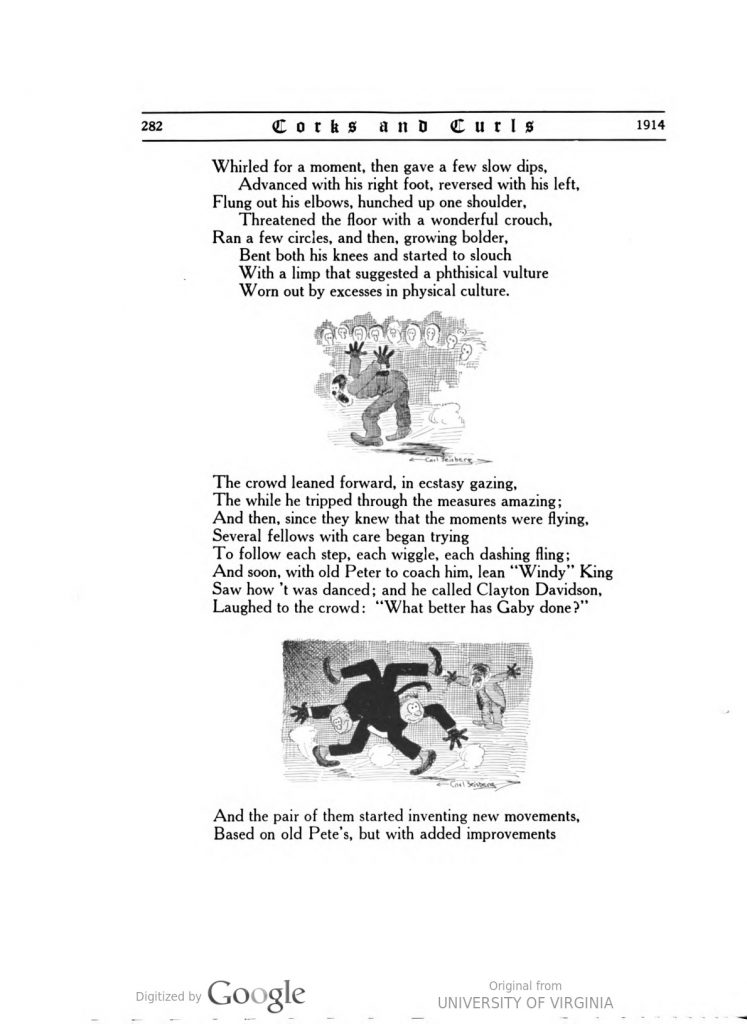
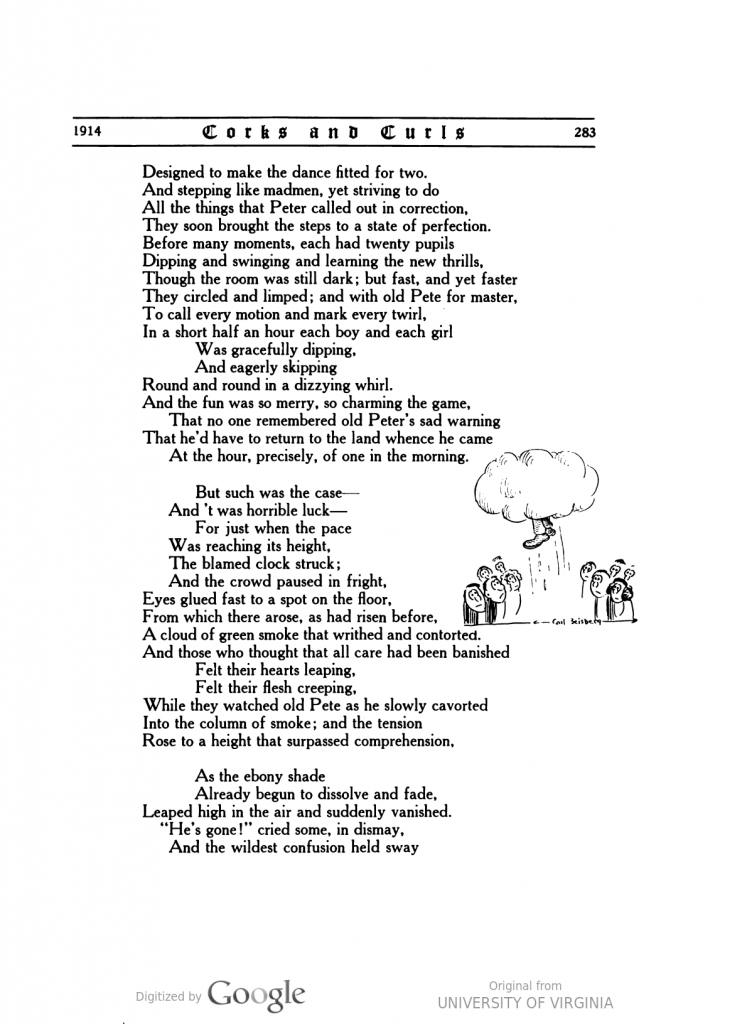
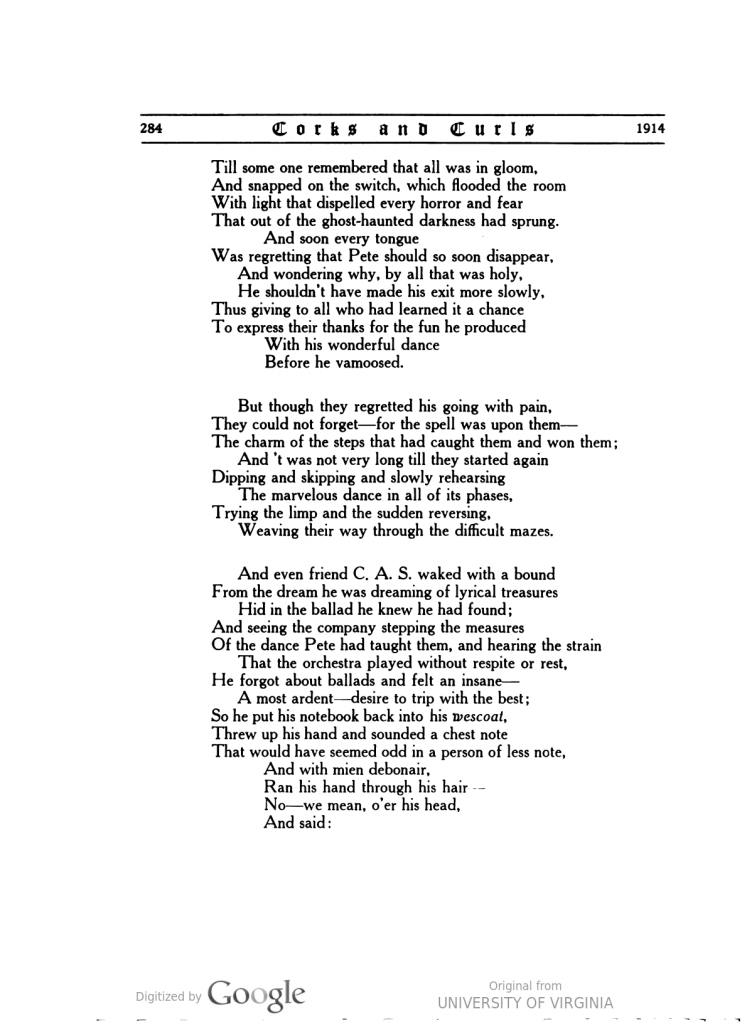
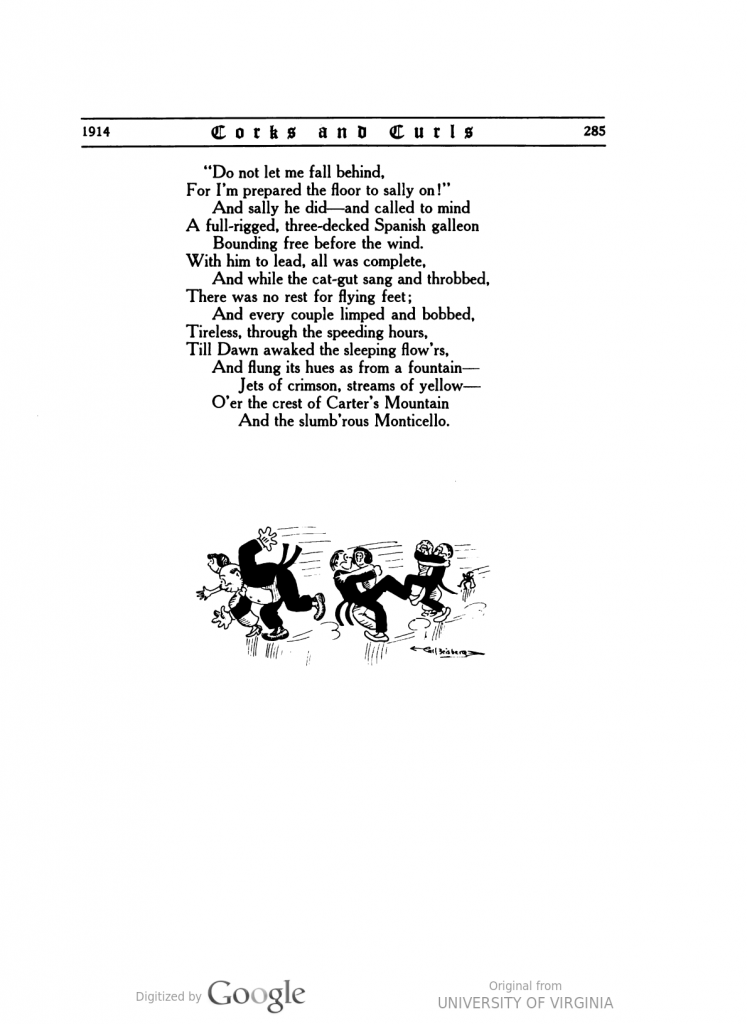
In a latter section of the book, there are several cartoons as headers for the state clubs. The Mississippi cartoon includes three blackface cartoons on a dock, playing a game of dice; the Kentucky cartoon displays a white man with a mustache with a blackface man singing in the background, nodding to a common minstrel stereotype of the happy slave; and finally, the South Carolina page illustrates a person in a white hood running and shooting at a blackface cartoon, whose head is drawn to demean blackness as primitive.[29] A year later, in the 1915 yearbook, the Florida club uses a Pickaninny caricature figure, of a young black child, being preyed upon by an alligator; another example of minstrelsy stereotypes which are rooted in racist caricatures of black lives.[30] The 1914 yearbook frames the future years of blackface and minstrel legacies, which are later expressed through photographs of blackface performances by the university Glee Club.
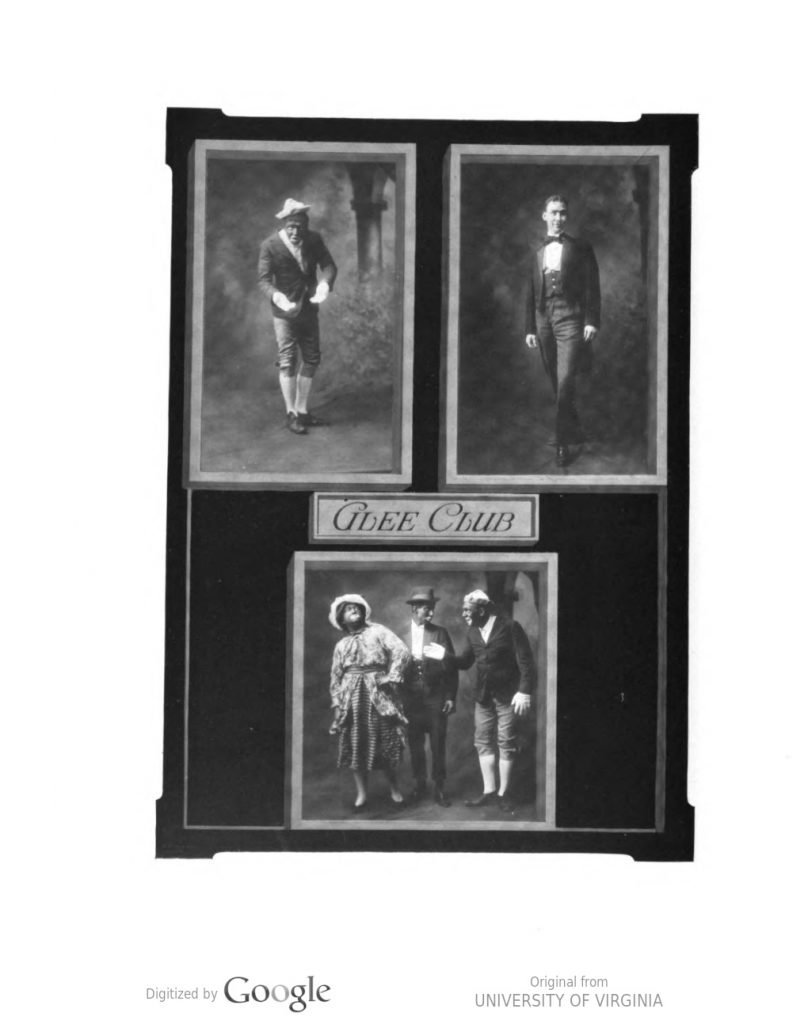
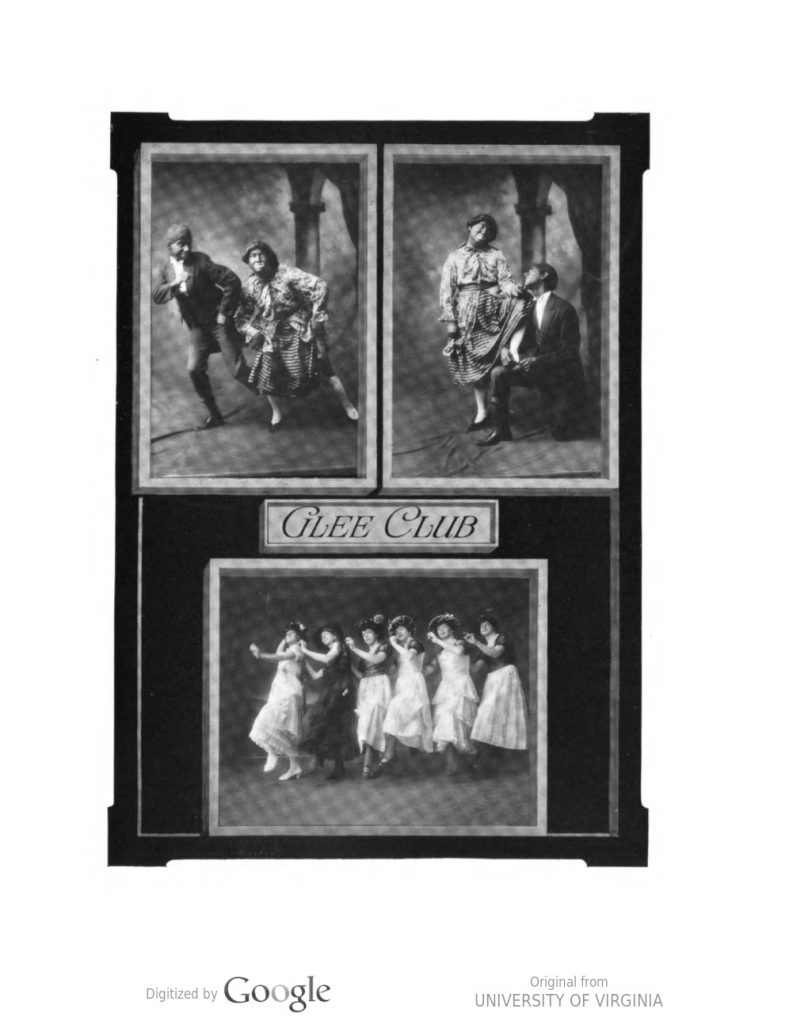
The Glee Club at the University of Virginia was first organized between the years 1893-94 but later disbanded by 1905, reestablishing themselves in the mid 1910s.[31] They became the predominant performers of blackface during this time period at UVA. In March of 1917, the first minstrel show is documented in Corks and Curls. The performance of “Oh, Julius!” by the Glee Club is photographed and the program included in the yearbook. The students are dressed in blackface and drag, as the entire cast is both white and male. The program lists the characters and acts of the play, seemingly a play about the Roman Julius Caesar that is adapted and takes place in the era of the 1800s in the South, as well as returning, in part, to Rome. Several students in blackface are photographed with large smiles and humorous poses. The show begins with a prologue, featuring two characters, Hans Hansen (a student) and Jeremiah Jefferson (a servant). There are two performances “Oriental Dance” and “Hawaiian Dance,” in addition to several quartettes, that were likely performed in blackface or yellowface, and in drag – as was common.[32] The Glee Club and Mandolin Club performance included music, a play, and an orchestra, concluding with the “Good Ole Song.” Nearly all of the photos included in the 1917 yearbook of the Glee Club were of students dressed in blackface. Throughout the yearbook are sporadic blackface cartoons accompanied by comics or short stories and the blackface caricatures return again in the state club pages, noting Alabama and Georgia.[33]
During the same time period of the 1917 Glee Club performance, the Jefferson Theatre showed “the great and typical comedy of the Southland” film titled, A Nigger in the Woodpile, on March 9th, 1917. The show is a 1904 silent film that is four minutes long and is named after the popular Southern idiom which refers to a dark skinned child birthed by a white woman and/or about runaway slaves.[34] The cast includes classical minstrel characters such as a ‘mammy’ figure, who is seen usually in a head scarf and apron and is evocative of the antebellum South role of enslaved black women; a Zip Coon character that depicts an “uppity” or “happy-go-lucky” slave figure; and an Uncle Remus character who is peaceful and elderly. The characters are performed in blackface and the plot entails a black church deacon who steals from a white farmer, a common minstrel story which paints black men as thieves. The showing of the film was advertised in the Daily Progress as well as the student newspaper, College Topics.
The next instance of celebrated blackface performance at the University was again by Glee Club in 1920. An image is recorded of a white male actor in blackface, dressed as a ‘mammy’ caricature, wearing a white apron dress and bandana headscarf.[35] The 1920 records in the Corks and Curls do not provide any additional details about what shows the photographs are from or who are in them. Photographs of blackface appear again in the 1921 yearbook section for the Glee Club, which includes an image of three students: two white characters dressed in 18th century aristocratic costumes, as well as white student in blackface dressed in a bald cap and aristocratic waistcoat.[36] After this 1921 photograph, the Corks and Curls does not include blackface images from Glee Club performances. However, blackface as embodied through cartoons, remains. Racist imagery continued to appear, such as the Law Review publication page in the 1922 yearbook, in which two blackface cartoons are drawn, one as a police officer in a tribal skirt and the other running, spilling a bottle and dressed in a stereotyped tribal attire.[37] Blackface returned not only as a performance, but as a visual and cultural trope aimed at maintaining their social status as servants, primitive, and enslaved as demarcated by whites.
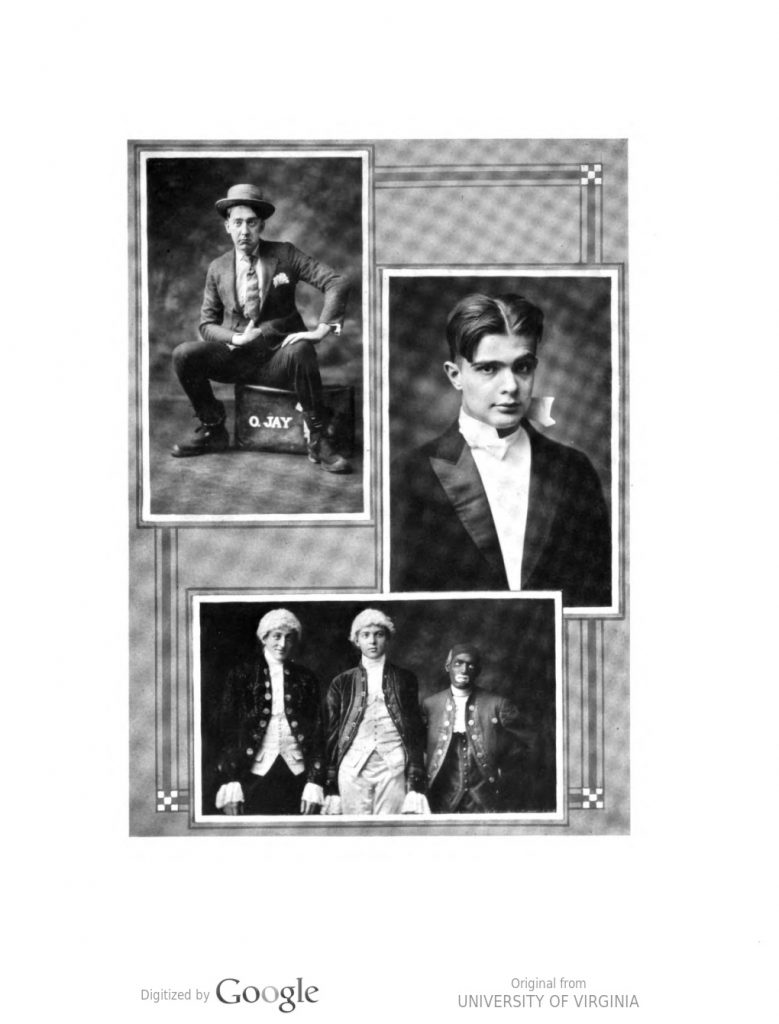
This revival of minstrelsy and blackface in both performances and cartoons marks the political and cultural sentiments of this era, resembling the local reinvigoration of white supremacy. In Charlottesville, the Robert E. Lee statue was commissioned in 1917 and unveiled years later, in 1924, to the city.[38] A statue commemorating Stonewall Jackson was commissioned in 1919 and unveiled in 1921.[39] The Corks and Curls documented these statues as well. The statues were part of a broader commitment of the Commonwealth to build a trail of memorials to the Civil War and followed the national trends of erecting Civil War monuments in the 1920s. Between these years of constructing monuments, the Charlottesville chapter of the Ku Klux Klan was established in the June of 1921 at Monticello.[40] In 1922, the Clubs and Organizations cover page depicts several Ku Klux Klan members dressed in hoods, riding in on horses and one thrusting a pitchfork into the air.
Blackface was not limited to theatrical musical or comedic performances during this time, and in fact, was regularly used as roleplaying or performed individually. In two photographs of the Jefferson Society, students appear to be roleplaying court scenes. In the photograph dated between 1925-26, students are dressed in costume, including drag, and a blackface character sits atop the court stand in Hotel C, Jefferson Hall.[41] In the 1927 photograph, the Jefferson Society members are in the Old Cabell auditorium, presenting a court scene again. The students are dressed in costumes, drag, and on the end, one blackface character sits slouched.[42] The use of blackface by the Jefferson Society points to a larger cultural norm which had been revived in the 1900s and into the 1920s; blackface was common, and intertwined with the construct of whiteness at the time, rooted in its distinction from blackness and coated in supremacist notions.
Blackface minstrelsy is recorded at the University of Virginia and mirrors the national, regional, and local sentiments of white supremacy – degrading the humanity of black lives through the stereotyped caricatures which depict bodies of African descent as thieves, primitive, and happy slaves. The use of blackface rationalized and trivialized the racial violence, intimidation, and oppression which arose after the Civil War and persisted well into the 20th century. Blackface minstrelsy is fundamentally about white fragility; and it peaks at moments in time when white masculinity is threatened. Blackface, it is important to note, did not disappear and continued to persist among the student body, appearing in the 1940s in Virginia Players shows and breaching into the 21st century as students wore blackface on Halloween. The history of blackface at the University places the eras of late 1800s and early 1900s in a broader context of intensified white supremacy. From lynching’s to Jim Crow, blackface falls into the narrative of racial violence that built the foundations of 20th century white supremacy.
Notes
[1] Lott, Eric. “’The Seeming Counterfeit’: Racial Politics and Early Blackface Minstrelsy,” American Quarterly 43, no. 2 (June 1991): 223-254.
[2] “Blackface: The Birth of An American Stereotype.” National Museum of African American History and Culture, 22 Nov. 2017.
[3] “Blackface: The Birth of An American Stereotype.” National Museum of African American History and Culture, 22 Nov. 2017.
[4] “Minstrelsy Structure and Iconography.” The History of Minstrelsy: From “Jump Jim Crow” to “The Jazz Singer”, University of South Florida.
[5] “Minstrelsy Structure and Iconography.” The History of Minstrelsy: From “Jump Jim Crow” to “The Jazz Singer”, University of South Florida.
[6] “Abolition.” The History of Minstrelsy: From “Jump Jim Crow” to “The Jazz Singer”, University of South Florida.
[7] “Collegiana”. Virginia University Magazine XV. p 47. October 1876.
[8] Bruce, Philip Alexander. History of the University of Virginia, 1819-1919: The Lengthened Shadow of One Man. (v.5)1922. p. 125.
[9] Bruce, 125; Culbreth, David Marvel Reynolds. The University of Virginia; Memoirs of Her Student-Life and Professors. University of Virginia Library, 1908. P. 465.
[10] “Collegiana”. Virginia University Magazine XV. October 1876.
[11] “Collegiana”. Virginia University Magazine XV. October 1876.
[12] “Collegiana” Virginia University Magazine XV. p 496. October 1876.
[13] “Collegiana” Virginia University Magazine XV. p 497. October 1876.
[14] “Collegiana” Virignia University Magazine XVI. p 114. November 1887.
[15] “Collegiana” Virginia University Magazine XVII. p 305.
[16] “Collegiana”. Virginia University Magazine XV. p 341. October 1876.
[17] Bruce, Philip Alexander. 1922. P. 125.
[18] “Collegiana”. Virginia University Magazine XXV. p 368. May 1886.
[19] University Minstrel Troupe Program, special collections, 1886
[20] Unviersity Minstrel Troupe
[21] “Collegiana”. Virginia University Magazine XXV. p 491. May 1886.
[22] “Blind Tom.” The History of Minstrelsy: From “Jump Jim Crow” to “The Jazz Singer”, University of South Florida.
[23] Bruce, Philip Alexander. 1922. p. 126.
[24] Hartsock, Peter. “Opinion | The Unfortunate Effects of ‘The Birth of a Nation’.” The
Washington Post, WP Company, 21 July 2017.
[25] University of Virginia. Corks And Curls. [Charlottesville, Va.: University of Virginia], 1914.
p. 303.
[26] University of Virginia. Corks And Curls. [Charlottesville, Va.: University of Virginia], 1914.
p. 143
[27] University of Virginia. Corks And Curls. [Charlottesville, Va.: University of Virginia], 1914.
p. 149
[28] University of Virginia. Corks And Curls. [Charlottesville, Va.: University of Virginia], 1914.
p. 276
[29] University of Virginia. Corks And Curls. [Charlottesville, Va.: University of Virginia], 1914.
p. (376, 382, 387)
[30] University of Virginia. Corks And Curls. [Charlottesville, Va.: University of Virginia], 1915.
p. 385
[31] Bruce, Philip Alexander. P. 288.
[32] University of Virginia. Corks And Curls. [Charlottesville, Va.: University of Virginia], 1917.
p. 315-317
[33] University of Virginia. Corks And Curls. [Charlottesville, Va.: University of Virginia], 1917.
p. 415/416.
[34] Stewart, Jacqueline Najuma (28 March 2005). Migrating to the Movies: Cinema and Black
Urban Modernity. University of California Press. pp. 1.
[35] University of Virginia. Corks And Curls. [Charlottesville, Va.: University of Virginia], 1920.
p. 278-79.
[36] University of Virginia. Corks And Curls. [Charlottesville, Va.: University of Virginia], 1921.
p. 311
[37] University of Virginia. Corks And Curls. [Charlottesville, Va.: University of Virginia], 1922.
[38] “Emancipation Park (Formerly Known as Lee Park).” City of Charlottesville.
[39] “History and Gardens of Justice Park.” City of Charlottesville.
[40] Chow, Kat. “Tracing The Dark Origins Of Charlottesville’s KKK.” NPR, NPR, 19 Aug. 2017.
[41] Holsinger’s Studio (Charlottesville, Va.). Jefferson Society. University of Virginia Library,
1925.
[42] Jefferson Society. University of Virginia Library, 1927.

